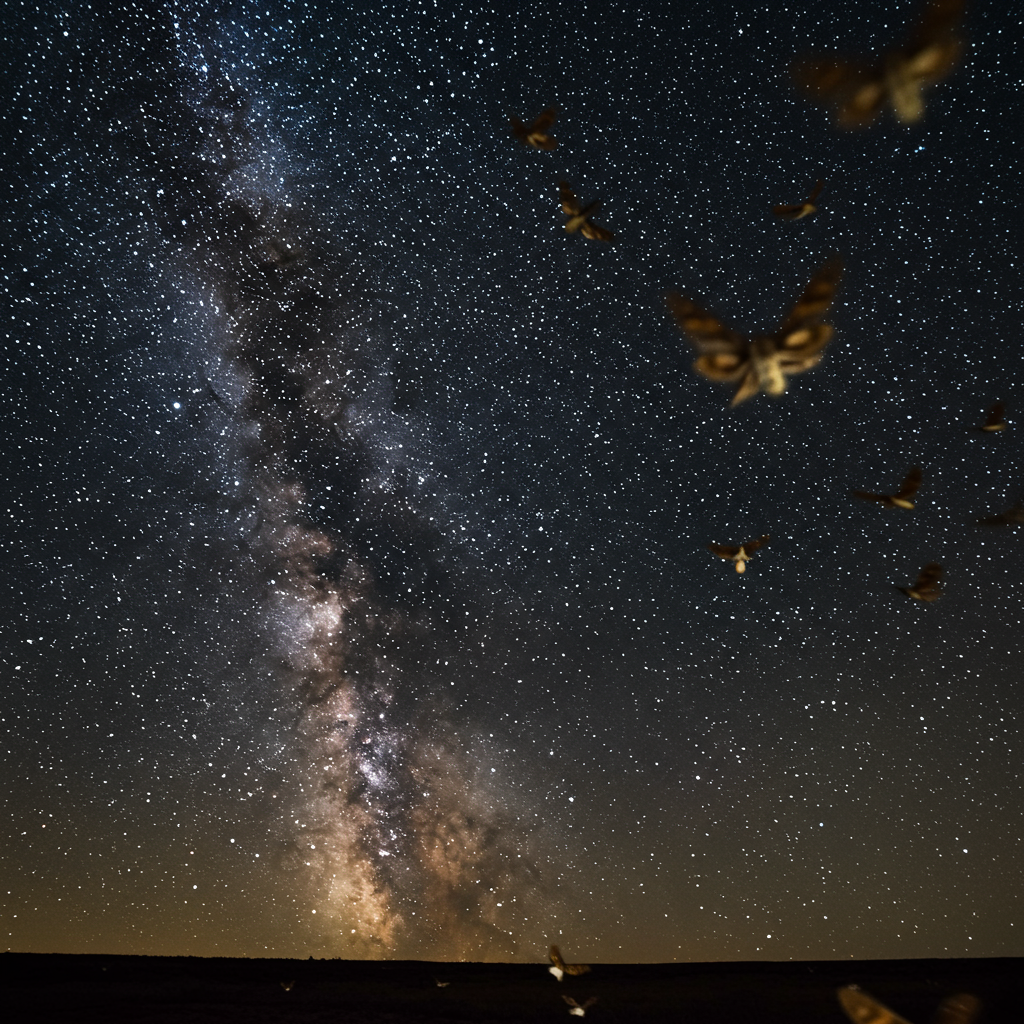Imagine navigating a journey of over 1,000 kilometers – roughly the distance between London and Berlin – but doing so with a brain smaller than a grain of rice, entirely at night, and to a destination you’ve never visited before. This incredible feat is accomplished annually by the Bogong moth (Agrotis infusa), a species native to southeastern Australia. For decades, scientists have marveled at the precise navigational abilities of these tiny insects as they undertake one of nature’s most remarkable migrations.
Now, groundbreaking research has unveiled a crucial secret behind their astonishing travels: Bogong moths use the starry night sky as a compass. This discovery adds another layer to the already complex understanding of how these delicate creatures find their way across vast distances, navigating to specific mountain caves where they aestivate (summer dormancy) before returning north to breed and complete their single-year life cycle.
The Extraordinary Journey of the Bogong Moth
Each year, millions of Bogong moths emerge from their inland breeding grounds in southern Australia. In spring, a new generation embarks on a southward journey, flying hundreds of kilometers to cool, specific alpine caves in the Australian Alps. They spend the hot summer months there, clustered together in vast numbers. When autumn arrives, the surviving moths then undertake the equally long and challenging return migration back north to their breeding areas.
This bidirectional migration is unique because the moths reaching the alpine caves and then returning north have never been there before. Their navigation isn’t learned; it’s an innate, inherited ability. This makes understanding their navigational tools critical, especially as the species was listed as endangered in 2021 following a catastrophic population collapse, partly linked to severe drought impacting their food sources and potentially their ability to complete these essential migrations.
Unraveling the Navigational Toolkit
Previous studies had shown that Bogong moths possess a sophisticated navigational system. They were known to be able to sense the Earth’s magnetic field and potentially use visual landmarks over shorter distances. However, the precise cues guiding their long-distance, nocturnal flights remained a puzzle. Researchers hypothesized that like daytime migrants such as monarch butterflies use the sun, night migrants might use celestial patterns – specifically the stars.
The Stellar Compass Discovery
To test this theory, scientists conducted ingenious experiments. They captured migrating Bogong moths and placed them in controlled environments designed to isolate potential navigational cues.
- Outdoor Tests: Under clear natural night skies, tethered moths oriented consistently towards their seasonal migratory direction (north-northwest in autumn). Crucially, they maintained this direction over hours, even as stars and the moon shifted across the sky, suggesting they can compensate for celestial rotation or use a time-compensated compass. When skies were completely overcast, obscuring celestial cues, the moths still oriented correctly, strongly indicating their reliance on the geomagnetic field when stars aren’t visible.
- Indoor Controlled Experiments: Researchers moved experiments indoors to a magnetically shielded laboratory, effectively nullifying the Earth’s magnetic field. In a dark tent with no visual or magnetic cues, moths became disoriented. However, when a realistic projection of the starry night sky was shown on the ceiling, the moths immediately oriented in their seasonally appropriate migratory direction (south in spring, north-northwest in autumn).
- Testing the Pattern: To confirm they were using the pattern of stars and not just general light, researchers rotated the projected starry sky by 180 degrees. The moths responded by reversing their flight direction by roughly 180 degrees. When the projected stars were randomly distributed (lacking the natural celestial configuration), the moths became completely disoriented. This provided direct evidence that the moths are using the spatial arrangement of stars as a navigational reference.
The Brain Processes the Cosmos
The study went further, exploring the neural basis of this remarkable ability. Using tiny electrodes, researchers recorded activity from neurons in key insect brain regions known for navigation and vision, such as the optic lobe, central complex (CX), and lateral accessory lobes (LAL).
These “stellar-tuned” neurons responded specifically to the rotation of the projected starry sky, but not to random star patterns. Different types of neurons showed peak activity at specific sky orientations. Intriguingly, many of these unimodal neurons showed consistent tuning towards the southern direction, regardless of the migratory season. While the exact mechanism is still being explored, these neurons likely play a vital role in encoding the celestial pattern and helping the moth calculate its desired migratory heading. Experiments mimicking prominent southern sky features like the Milky Way also stimulated responses in some neurons, suggesting they might be using the extended shape or bright regions of the galaxy.
A First for Invertebrates
While some insects, like dung beetles, are known to use the Milky Way for short-distance orientation to maintain a straight line, the Bogong moth’s capability is far more sophisticated. They use stars to navigate towards a specific, distant geographical destination over many nights, compensating for the movement of the night sky throughout their journey and potentially for external factors like wind. This level of long-distance, stellar-based geographical navigation was previously thought to be unique to humans and certain night-migratory birds.
Dual-Compass System: Strength in Numbers
The findings confirm that Bogong moths possess a dual-compass system, relying on both the starry sky and the Earth’s magnetic field. Either cue appears sufficient on its own for orientation. This redundancy provides a robust navigation system, allowing them to find their way even when one cue is unavailable, such as under overcast skies (using magnetism) or in areas with magnetic anomalies (using stars).
Remaining Mysteries and Conservation
Despite these breakthroughs, questions remain. Researchers are still investigating exactly which specific stellar features the moths prioritize – are they using the brightest stars, constellations, or the extended shape of the Milky Way? How do the brain’s southern-tuned neurons contribute to computing both northbound and southbound routes? And critically, how do the stellar, magnetic, and potentially other cues (like smell or visual landmarks near the destination) integrate and calibrate within the moth’s tiny brain to ensure such precise long-distance travel?
Unraveling these complex navigational strategies is more urgent than ever as scientists race to understand and protect the endangered Bogong moth. This tiny insect’s ability to navigate by the stars highlights the astonishing capabilities of even small nervous systems and underscores the intricate wonders of the natural world we are still just beginning to understand.




